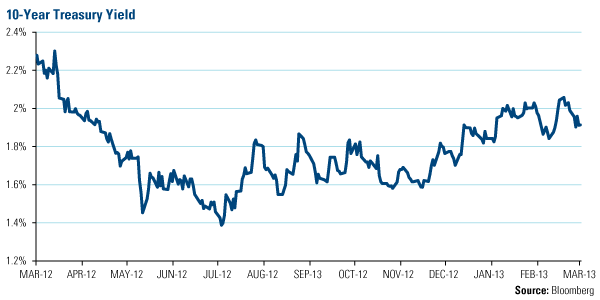The Economy and Bond Market Radar (March 25, 2013)
The 10-year Treasury yield fell for a second consecutive week following news out of Europe that Cyprus may enact a tax on bank deposits, fueling fund flows out of the equity market into bonds.
Strengths
- The U.S. housing market appears to be recovering after stagnating for five years. Housing starts came in at a seasonally adjusted annual rate of 917,000. That’s up from 910,000 in January. And it’s the second-fastest pace since June 2008, behind December’s pace of 982,000.
- Building permits, a sign of future housing construction, increased 4.6 percent to 946,000. That was the most permits since June 2008.
- Additionally, existing home sales rose to their highest level in more than three years, while prices increased nationwide, yet another indication of a housing rebound that bodes well for the overall economy.
Weaknesses
- The Eurozone Purchasing Managers Index fell from 47.9 in February to 46.5 in March, according to the flash estimate. The decline signaled an acceleration in the rate of contraction of business activity for the second consecutive month to the steepest experienced for four months.
- U.K. inflation accelerated to the fastest pace in nine months in February and factory-gate prices increased twice as much as forecast as energy costs surged and the British pound declined.
Opportunity
- The Fed continues to remain committed to an extremely accommodative policy.
- Key global central bankers, such as the European Central Bank, the Bank of England and the Bank of Japan, are still in easing mode. The Bank of Japan in particular appears willing to implement additional monetary policy easing in the near future.
Threat
- The economy appears to be gaining momentum. The risk for bondholders is that this trend continues and bonds sell off.
- Inflation in some corners of the globe is getting the attention of policy makers and may be an early indicator for the rest of the world.




 click to enlarge
click to enlarge




